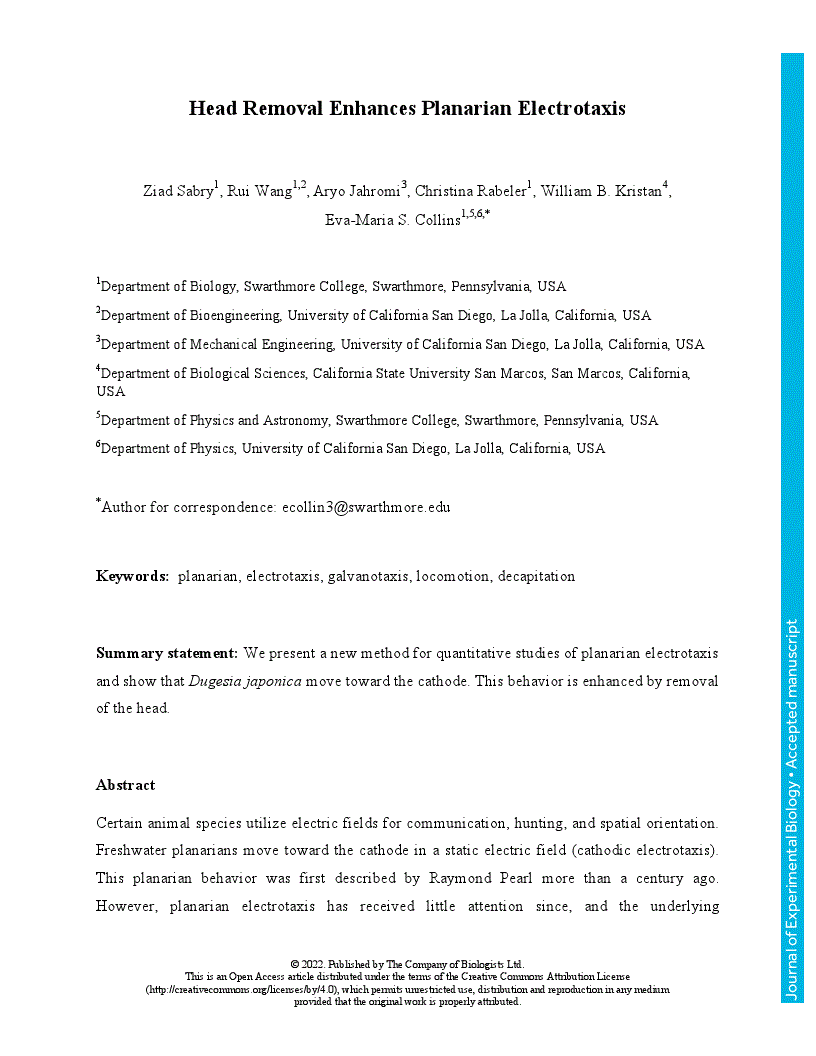Certain animal species utilize electric fields for communication, hunting, and spatial orientation. Freshwater planarians move toward the cathode in a static electric field (cathodic electrotaxis). This planarian behavior was first described by Raymond Pearl more than a century ago. However, planarian electrotaxis has received little attention since, and the underlying mechanisms and evolutionary significance remain unknown. To close this knowledge gap, we developed an apparatus and scoring metrics for automated quantitative and mechanistic studies of planarian behavior upon exposure to a static electric field. Using this automated setup, we characterized electrotaxis in the planarian Dugesia japonica and found that this species responds to voltage instead of to current, in contrast to results from previous studies using other planarian species. Surprisingly, we found differences in electrotaxis ability between small (shorter) and large (longer) planarians. To determine the cause of these differences, we took advantage of the regenerative abilities of planarians and compared electrotaxis in head, tail, and trunk fragments of various lengths. We found that tail and trunk fragments electrotaxed while head fragments did not, regardless of size. Based on these data, we hypothesized that signals from the head may interfere with electrotaxis when the head area/body area reached a critical threshold. In support of this hypothesis, we found that (a) smaller intact planarians which cannot electrotax have a relatively larger head-to-body-ratio than large planarians which can electrotax, and that (b) electrotaxis behavior of cut head fragments was negatively correlated with the head-to-body ratio of the fragments. Moreover, we could restore cathodic electrotaxis in head fragments via decapitation, directly demonstrating inhibition of electrotaxis by the head.
Head removal enhances planarian electrotaxis
- Award Group:
- Funder(s): National Science Foundation
- Funder(s):
Currently Viewing Accepted Manuscript - Newer Version Available
Ziad Sabry, Rui Wang, Aryo Jahromi, Christina Rabeler, William B. Kristan, Eva-Maria S. Collins; Head removal enhances planarian electrotaxis. J Exp Biol 2022; jeb.243972. doi: https://doi.org/10.1242/jeb.243972
Download citation file:
Advertisement
2023 JEB Outstanding Paper Prize shortlist and winner

The JEB Editors are delighted to announce the shortlisted authors for the 2023 JEB Outstanding Paper Prize. Read the winning paper - Tiny spies: mosquito antennae are sensitive sensors for eavesdropping on frog calls - by Hoover Pantoja-Sanchez and Brian Leavell from Ximena Bernal's lab at Purdue University, USA.
JEB Science Communication Workshop for ECRs

If you’re an early-career researcher interested in science communication and are attending the SEB Annual Conference in Prague this summer, come a day early and join the JEB Editors at a sci comm workshop to learn the key writing skills needed to promote your research to a broad audience beyond your peers (1 July at 14.30-17.30). Places are limited to 24 attendees, and applicants should apply through the SEB registration page by 30 April 2024.
Bridging the gap between controlled conditions and natural habitats in understanding behaviour

Novel technologies enable behavioural experiments with non-model species, in naturalistic habitats and with underexplored behaviours. In their Commentary, Scholz and colleagues discuss how to obtain a deeper understanding of the natural ecology and lifestyle of study animals.
Beluga metabolic measures could help save species

To help save animals from extinction, it’s important to understand what each species needs to survive. This led Jason John et al. to measure the metabolic rates of captive belugas to develop a ‘fish calculator’ showing that the whales need to eat ~23 salmon per day.
ECR Workshop on Positive Peer Review

Are you an ECR looking for tips on how to write concise, astute and useful manuscript reviews? If so, join the JEB Editors at a 2-hour JEB-sponsored Workshop on Positive Peer Review at the Canadian Society of Zoologists annual meeting in Moncton on 9 May 2024 at 13.00-15.00. There are 25 spaces for ECRs and selection is first come, first serve. To sign up, check the ECR Workshop box when you register for the CSZ meeting.



